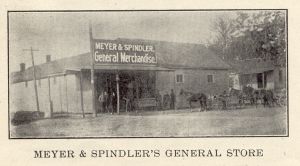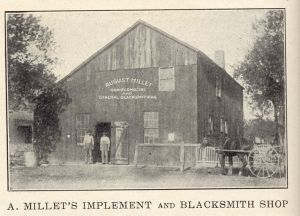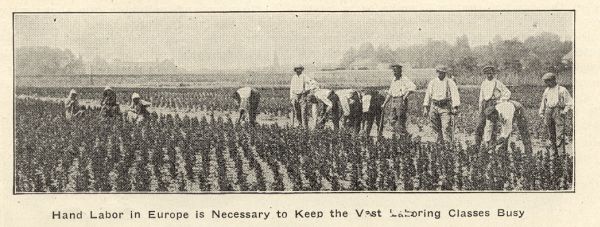|
Page 52 |
|
|
Huey is a quiet little village, the inhabitants of which are largely retired farmers. This little settlement as early as 1826 was the meeting place of members of the Methodist church. One of the early preachers, Joseph FOULKES, in 1826, killed a half-breed Indian who had threatened his life. Huey at the present time has a population of 250 inhabitants and is located on the main line of the Baltimore and Ohio, four miles east of Carlyle, the county seat. It has two large general stores, one grocery, one large blacksmith and implement business, one saloon, a harness shop, one meat market, one saw mill and several smaller business concerns, besides an hotel. MEYER and SPINDLER MEYER and SPINDLER conduct the largest and most up-to-date general store in the city. It was started many years ago by other business men and in 1909 the present firm took possession. They carry a $6,800.00 stock of merchandise. They do a yearly business amounting to over $15,000. They carry a complete line of general merchandise, hardware, drugs and produce. Both young men are from St. Louis, where they had previously been in the grocery business. Wm. MEYER was born in Washington county in 1875 and is the son of Gottlieb MEYER. His mother died when he was 8 months old. There were nine children in the family. He was married to Martha BUSMANN in 1900, and has a daughter six years old. D. W. SPINDLER was born in Berger, Mo., in 1872, and is a son of Simon and Mary SPINDLER. He is also one of nine children. He was married in 1895 to Adeline BUSMANN,
and has three children, two boys and one girl. Their ages range from 17 to 12 years of age. The firm is also in the grain business and operate the elevator in Huey for the Carlyle Milling Co. It has a capacity of 12,000 bushels, and all grain bought is shipped to the mill. An average of 25,000 bushels is shipped yearly. August MILLET Mr. MILLET conducts the implement and blacksmith shop south of the depot. He has been in business since 1904 |
having bought out the business then from Louis BRAUN. He does general blacksmithing, woodwork of all kinds, horseshoeing and manufactures and repairs wagons of all kinds. He also sells the P. & O. implements, buggies and wagons. He has been a resident of Huey for the past nine years and was born near the city in 1874. His schooling was received in the country schools near Huey. Previous to locating in business he was engaged in the same business on his father’s farm. His parents are
French, having been born in France, but settled in Clinton county in 1854, being some of the early settlers of the county. His father’s name is Francis and his mother’s Josephine. For many years the family lived seven miles southeast of Huey and the parents of August still live there. Mr. MILLET was married in 1905 to Emma KIESTER, who resided near his father’s home. He is the father of three children, one boy and two girls, the oldest being seven years, and the youngest 2. HOGSHEAD and SHORT J. A. HOGSHEAD started into the general merchandise business in Huey in August, 1898 with a stock of goods valued at $800.00. From time to time after that he kept increasing the stock until today the firm, which now comprises J. A. HOGSHEAD and O. L. SHORT, have a stock of goods valued at $2,000. SHORT became a partner in 1908. They average business yearly amounts to over $7,000.00. They handle a complete line of dry goods, hardware, notions, cigars, tobacco, candy, flour and produce. It is the oldest general store under one management in the city. Mr. HOGSHEAD was born in Washington county in 1863 and for many years attended the schools of Nashville. He is a son of Andrew and Sophronia HOGSHEAD, and one of nine children. He was married in 1890 to Anna CARSON and has two children, Mamie, 2 years of age and Ruby 15. His father was born in Pennsylvania and his mother in St. Clair county. Mr. SHORT was born in Clinton county and is the son of John W. and Charity Elizabeth SHORT, both of whom were born in the county. |
|
Page 53 |
|
|
He was married in 1906 to Katie SCHMIDT and has one child. The store conducted by these enterprising men is doing an excellent business and is one of the progressive stores of the town. FARM LABOR IN EUROPE. By Clayton C. Pervier. LABOR conditions on. the farms of Europe are almost exactly the opposite of what they are in this country. Here there is a great scarcity of labor and high wages. The farmers are doing every possible thing to get away from hand labor. They are buying every labor-saving device on the market that will make farm work easier and more expeditious. We have been forced into this, in a great measure, by insufficient help, but often there has been the desire to make work easier regardless of cost. We use the self binder with bundle carrier attachment, the mowing machine, horse rake, hay loader |
France, Switzerland, Germany, Belgium and Holland - they are seen in every kind of occupation. In Belgium there are 300,000 women employed in agricultural work. There they have an agricultural school especially for girls, where they are taught all the details of farm work, do all the work on the school farm, including planting and care of the crops, tending the dairy herd and making butter and cheese. On the farms women are seen cutting grain and grass with the scythe, binding and shocking the grain, spreading manure in the fields and caring for the live stock in the barns. They haul in grain and hay from the fields with the one-horse or one-cow cart, thresh grain and plow the land. I have seen them butchering animals in the slaughter houses, working in the stockyards, and cleaning and polishing our shoes when we came out of the yards. On the streets of Munich I have seen women with big sheet iron pans and brush brooms sweeping up the droppings in the street as fast as they fall, putting them in hand carts which are wheeled away and the con• tents sold for fertilizer. |
|
|
|
|
and horse hay fork. We use riding plows, cultivators and machinery of every description to save the labor of walking. We use harvesting machines that cut, thresh and bag the grain, all at the same time. Engine power is used for hauling huge plows, running farm machinery and pumping water for the live stock. Grain elevators are used to unload corn into the cribs and wheat into the bins to save the labor of shoveling. Corn fodder is cut, bound, chopped into small pieces and elevated into a silo by machinery. We ride to and from our work and use wagons, buggies and automobiles for road travel, walking only when it cannot be avoided. The labor saving tools, implements and machinery on an average 160-acre farm would make a rare and interesting museum for an old world agricultural college. We are at high tide in labor-saving devices and the turn must come to more intensive hand labor, if we are going to feed our own people. Now, one man with a number of horses and big implements is farming every possible acre by his own labor alone. In Europe, on the other hand, wages are low and labor abundant. Instead of using labor-saving machinery the problem is to find work for all the people at wages upon which they can live. The population is dense and the struggle among the laboring classes to make a decent living is great. Women do every kind of work on the farms and in some sections are more numerous than the male laborers. In England their work is mainly in the hay and harvest fields and with the hoed crops. On the continent - in |
A woman does nearly as much work on the farm in a day as a man and in some occupations quite as much, but she receives only a little more than half the pay. The general farm wages paid for men are 50 to 65 cents a day. If employed by the year house rent is free and perhaps a certain quantity of potatoes in addition. The day laborer boards himself and pays rent for the house. Women recive 30 to 35 cents a day and in some sections less. On one farm in France the proprietor told us he paid his women laborers 40 cents a day and that they worked fourteen hours a day. The workmen in the fields never appear to hurry, but keep plodding along, putting in more hours than we, but expending much less nervous energy. When the farmers were asked why they did not use more binders and mowers and thus get in their crops quicker, the reply was, invariably, that they could do the work cheaper by hand and that the laborers must have employment. The introduction of labor-saving machinery would deprive these people of a means of livelihood and it is only on the larger farms that any is now seen. Instead of getting away from hand labor as we have been forced to do they are compelled to dispense with labor-saving machinery to meet the existing labor conditions. In most of the European countries the farmers and farm laborers live in villages and walk to and from the lands cultivated. When hauling in the crops the driver usually walks beside his horse, cow or oxen, as the case may be. |
|
Page 54 |
|
|
Labor is so cheap in Europe that I have seen men sitting by the roadside crushing rock with a hammer, for road construction. Possibly they were working out their road tax on the American plan. A teamster in England told me he received 16 shillings (four dollars) a week and that he paid three shillings (75 cents) a week for the support of his family. If it were not for the fact that rents and manufactured goods are much lower than here, he would be wholly unable to care for his family. The standard of living for the laborers and tenant farmers of Europe is far below that enjoyed in the United States. They are forced to deprive themselves of the more expensive foods and must use the cheapest of everything. |
the cheaper rye for the more expensive wheat bread. Food, such as is commonly used in this country, is about as high priced in Europe as here and some kinds higher. Beef was selling at 22 to 25 cents a pound; eggs, varying with the season, 30 to 65 cents a dozen and butter, 30 to 50 cents a pound. Horse meat sells at about half the price of good beef, or 11 to 13 cents a pound. In Germany the diseased cattle, condemned by the city inspectors, are slaughtered by the city authorities and all that is considered fit to use by cooking enough to kill the disease germs, is cooked by the city and sold to the people at 11 to 12 cents with a guarantee that it is safe to eat. This meat is thoroughly cooked and undoubtedly contains |
|
|
|
|
Meat, eggs, butter and poultry are rarely seen on the farm laborer's table and the farmer who produces them must sell them and use cheaper products himself. Even the traveler at the best hotels on the continent gets butter but once a day, and then only at breakfast with his coffee and rolls, and nothing else. How many of our farm laborers would be satisfied with that kind of breakfast, day after day? I have seen many farm laborers sitting under the trees eating their noonday lunch - a chunk of rye bread and perhaps an onion or sometimes a dried fish with it. We Americans, who are the most wasteful and extravagant people in the world, know little about the economy of living. Right in our local town, in Illinois, creamery |
the most food value of any meat the poor people can buy. In fact this and horse meat are about the only meats they are able to buy at all. In Dresden we visited an abattoir where dogs are slaughtered, 12 to 15 a month, we are told. The conditions in these countries are such that these kinds of meats must be used for food among the poorer classes. Nothing is permitted to go to waste that can be utilized for food. There is little hope for the laborers to ever better their conditions under present wages or accumulate any reserve for the future and it is little wonder that they come to this country whenever they can secure the means for transportation. There are few farm laborers who get here and they do not get into the country and on the farms where, they |
|
|
|
|
butter is selling for 39 cents a pound and corn is worth 37 cents a bushel. Just think of giving a bushel of corn and two cents thrown in, for one pound of butter! Stop a moment and think how far a bushel of corn ground into cornmeal will go in food value, as compared with one pound of butter and see if we don't need to learn something in economy of living. The European farm laborers, both men and women, appear to be strong, healthy and well nourished by their simple diet. They have learned by force of conditions that the cheaper foods may be even more nutritious than the more expensive kinds. In Saxony, one of the best wheat producing sections of Germany, and where large crops are grown, we were told that rye bread is used and practically all of the wheat exported, thus substituting |
are most needed. Being accustomed to living in villages and unfamiliar with our system of farm life, they naturally seek the cities and towns. So much of the farm work of Europe is garden culture and hand labor that this class of immigrants would be out of place on our farms in the management of horses and machinery and they are better suited to the gardening districts surrounding the larger cities. In the year ending June 30, 1900, there was exported in the form of wheat and flour the equivalent of 186,097,000 bushels, or 28.3 per cent of the crop of 1909. The value of the oats crop grew from $217,000,000 in ].899 to $415,000,000 in 1909 or 91 per cent. |
This file last modified




